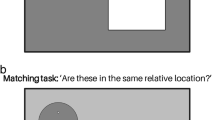Summary
It has been shown that spatial compatibility is due to a comparison between the spatial codes that describe stimulus and response positions. Such codes are often defined in right-left terms. There are, however, two types of right-left codes that can be used for describing a position in space. One is formed with relation to the egocentric axes and can be termed “side”, whereas the other is formed with relation to an external reference location and can be termed “relative position”. Five experiments were conducted to determine the role of these different codes in producing spatial compatibility effects. In Experiments 1 and 2 the position of the stimulus provided the relevant cue for choosing the correct response (i.e., the situation was typical of spatial compability proper), whereas in Experiments 3, 4, and 5 the stimulus provided a locational cue that was not necessary for choosing the correct response (i.e., the situation was typical of the Simon effect). The experimental manipulations concerned the task demands and the time elapsing between availability of the stimulus code and availability of the response code. The results showed that upon stimulus presentation, both stimulus codes (that concerning side and that concerning relative position) were formed, but experimental manipulations determined the one that was effective in yielding compatibility effects. When the task required the use of one type of code, then spatial compatibility depended on that code alone. When the two coding processes were separated in time, then spatial compatibility depended only on the code that was formed simultaneously with the response code.
Similar content being viewed by others
References
Bradshaw, J. L., Nathan, G., Nettleton, N. C., Pierson, J. M., & Wilson, L. E. (1983). Head and body hemispace to left and right. III. Vibrotactile stimulation and sensory and motor components. Perception, 12, 651–661.
Brebner, J. (1973). S-R compatibility and changes in RT with practice. Acta Psychologica, 37, 93–106.
Brebner, J., Shepard, M., & Cairney, P. (1972). Spatial relationships and S-R compatibility. Acta Psychologica, 36, 1–15.
Dyer, F. N. (1973). The Stroop phenomenon and its use in the study of perceptual, cognitive, and response processes. Memory & Cognition, 1, 106–120.
Heilman, K. M., & Valenstein, E. (1979). Mechanisms underlying hemispatial neglect. Archives of Neurology, 5, 166–170.
Jensen, A. R., & Rohwer, W. D., Jr. (1966). The Stroop color-word test: A review. Acta Psychologica, 25, 36–93.
Nicoletti, R., Anzola, G. P., Luppino, G., Rizzolatti, G., & Umiltà, C. (1982). Spatial compatibility effects on the same side of the body midline. Journal of Experiment Psychology: Human Perception and Performance, 8, 664–673.
Nicoletti, R., & Umiltà, C. (1984). Right-left prevalence in spatial compatibility. Perception & Psychophysics, 35, 333–343.
Nicoletti, R., & Umiltà, C. Splitting the visual world through focal attention. Manuscript in preparation for publication.
Nicoletti, R., Umiltà, C., & Ladavas, E. (1984). Compatibility due to the coding of the relative position of the effectors. Acta Psychologica, 57, 133–143.
Pierson, J. M., Bradshaw, J. L., & Nettleton, N. C. (1983). Head and body space to left and right, front and rear. I. Unidirectional competitive auditory stimulation. Neuropsychologia, 21, 463–473.
Schneider, R., Dumais, S. T., & Shiffrin, R. M. (1984). Automatic and control processing and attention. In R. Parasuraman, & D. R. Davies (Eds.), Varieties of attention (pp. 1–27). London: Academic Press.
Shiffrin, R. M., & Schneider, W. (1977). Controlled and automatic human information processing. II. Perceptual learning, automatic attending, and a general theory. Psychological Review, 84, 127–190.
Simon, J. R. (1969). Reactions toward the source of stimulation. Journal of Experimental Psychology, 81, 174–176.
Simon, J. R. (1982). Effect of an auditory stimulus on the processing of a visual stimulus under single- and dual-tasks conditions. Acta Psychologica, 51, 61–73.
Simon, J. R., & Acosta, E., Jr. (1982). Effect of irrelevant information on the processing of relevant information: Facilitation and/or interference? The influence of experimental design. Perception & Psychophysics, 31, 383–388.
Simon, J. R., Acosta, E., Jr., & Mewaldt, S. P. (1975). Effect of locus of warning tone on auditory choice reaction time. Memory & Cognition, 3, 167–170.
Simon, J. R., Acosta, E., Jr., Mewaldt, S. P., & Speidel, C. R. (1976 a). The effect of an irrelevant directional cue on choice reaction time: Duration of the phenomenon and its relation to stages of processing. Perception & Psychophysics, 19, 16–22.
Simon, J. R., Mewaldt, S. P., Acosta, E., Jr., & Hu, J. M. (1976 b). Processing auditory information: Interaction of two population stereotypes. Journal of Applied Psychology, 60, 354–358.
Simon, J. R., Sly, P. E., & Vilapakkam, S. (1981). Effects of compatibility of S-R mapping on reactions toward the stimulus source. Acta Psychologica, 47, 63–81.
Teichner, W. H., & Krebs, M. J. (1974). Laws of visual choice reaction time. Psychological Review, 81, 75–98.
Umiltà, C., & Nicoletti, R. (1985). Attention and coding effects in S-R compatibility due to irrelevant spatial cues. In M. I. Posner & O. S. M. Marin (Eds.), Mechanisms of attention: Attention and performance XI (pp. 457–471). Hillsdale, NJ: Erlbaum.
Wallace, R. J. (1971). S-R compatibility and the idea of the response code. Journal of Experimental Psychology, 88, 354–360.
Wallace, R. J. (1972). Spatial S-R compatibility effects involving kinesthetic cues. Journal of Experimental Psychology, 93, 163–168.
Author information
Authors and Affiliations
Rights and permissions
About this article
Cite this article
Umiltà, C., Liotti, M. Egocentric and relative spatial codes in S-R compatibility. Psychol. Res 49, 81–90 (1987). https://doi.org/10.1007/BF00308672
Received:
Issue Date:
DOI: https://doi.org/10.1007/BF00308672




